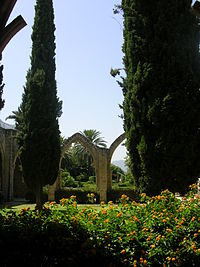Kyrenia
Kyrenia (Greek: Keryneia (Κερύνεια), Turkish: Girne) is a town in northern Cyprus, part of the de facto (but not internationally recognized) Turkish Republic of Northern Cyprus (TRNC). The town is known for its historic harbour.
In its heyday the town harbour was lined with warehouses in which were stored the fruits of the countryside whilst they awaited export. The harbour is currently used largely for pleasure craft, and the buildings are now mostly all restaurants, with outdoor tables along the water. A larger harbour is located a few miles east of the town centre, used by commercial shipping and ferries from the Turkish mainland.

The castle at the east end of the old harbour is a very spectacular site and within its walls there is a twelfth century chapel showing reused late Roman capitals. TThe main features of the exterior of the castle are the huge round towers built by the Venetian in 1540 AD. This was a period of history when gunpowder, cannons and the use of artillery were being developed for the first time in military operations .The Old Crusader Castle was changed and huge high walls with round towers at the corners were built. A round tower is more difficult to destroy with cannon fire than a square tower, and so a new type of military warfare arose in the 16 th century .The Venetian built many gun ports at three levels where cannon fire could be directed against attackers from the land. This proves that the Venetians were afraid of an attack from the Cypriots and not from the sea. Inside the castle, huge long ramps were built so that the artillery could be rolled up to the gun ports on the walls. The Old Crusader walls and towers were strengthened and improved so that the whole castle was carefully planned to meet a landlord attack. However, this was all in vain as a major siege never occurred.

The inner courtyar of the is vast and in one of the rooms leading off it is the Shipwreck Museum, exhibiting the remains of a 4th century Greek ship, discovered by a Greek-Cypriot diver in 1967, salvaged not far from Kyrenia together with its cargo. The Kyrenia ship as it is called, was extensively covered by the National Geographic Society.
One can identify the three main castles of the Kyrenia Castle:
- 1.Byzantine Castle [ 330 AD-1192 AD]
- 2.Crusader Castle [1192 AD-1472 AD]
- 3.Venetian Castle [1472 AD-1570 AD]
The town has an icon museum housed in a church which was dedicated to the Archangel Michael, not far from it there are some tombs cut into the rock dating from about the 4th century, there is a ruined small Christian church behind the harbour and in the harbour is a small tower from which a chain could be slung to close the harbour to any enemies. The Anglican church of St Andrew's is behind the castle and close to the bus station and is open all year round.

Bellapais Abbey (derives from the French "abbey de la paix" which means the Peace Monastery) in the Turkish occupied village of Bellapais in Kyrenia district Cyprus. The initial building was constructed between 1198-1205. The main building as it can be seen today was built during the 13th century A.D. by the Franks (French) monks of St. Augustine order, and specifically during the rule of King Hugh III 1267-1284. The pavilions around the courtyard and the refectory were constructed during the rule of King Hugh IV between 1324-1359. You can also see the Ancient Greek Orthodox Church of Mother Mary White Dressed.
Outside the town, on the Kyrenia Mountain Range, you can see the Bouffavento Castle, St. Hilarion Castle and Kantara Castle. During the Lusignan rule it was a prison and called ‘Chateau du Lion,' since when Richard the Lion Heart conquered Cyprus in 1191, the Byzantine despot King of the island, Isaac Comnenus, is said to have fled here. The Mountaintop castle of St. Hilarion dominates the town of Kyrenia and is visible for many miles along the coast.Historical records show that the castle was originally a monastery, founded about 800 and when a monk by the name of Hilarion chose the site for his hermitage. Later, perhaps 1100 AD the monastery was changed into a castle. The easternmost of the three castles on the Kyrenia mountains, the Kantara castle,is thought to have been constructed by the Byzantines following the Arab raids on the island like the other two castles, sources only make a mention of the castle in the year 1191, when Richard Lion-Heart captured the island.
In 1974, Kyrenia was the first town that was taken over during the invasion of the island by Turkey. Its Greek Cypriot inhabitants fled at the time to the south of the island, where the internationally-recognized government of Cyprus was still in power. Since then it has been under occupation by the Turkish army, de-facto TRNC. Kyrenia at present is populated by Turkish Cypriots and Turkish settlers.
While the people of Kyrenia were brutally expelled from their ancestral homes and were forced to endure the pain and suffering of being refugees in their own country, they have not disappeared. Through their collective efforts, their Municipality and Folklore Society they continue their work from Nicosia. Through special voters' registration and procedures, the people of Kyrenia continue to exercise their separate political and civic rights. The Bishop of Kyrenia continues to oversee to the religious affairs of the community. All traditional holidays, religious and cultural, are celebrated and kept alive by the people of Kyrenia. Through their work, their clubs and societies they vow to never stop fighting for the restoration of their human rights and their eventual return to their homes.The current mayor of Kyrenia is Constantinos Orologas.
